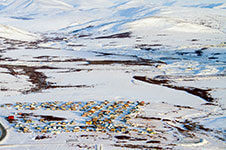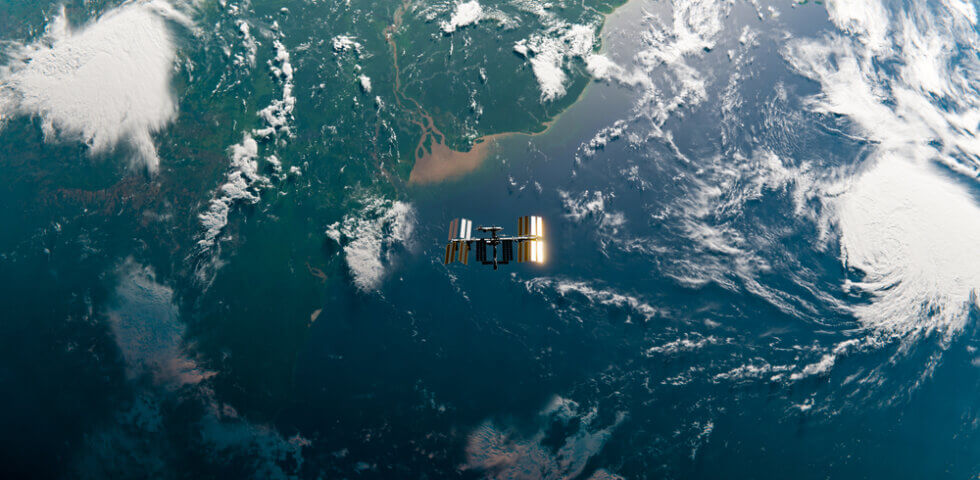Quintillion is known primarily for being the only telecommunications company to have built a subsea fiber optic cable system in the US Arctic. However, Quintillion also supports the development of satellite communication in the United States with its ground station services. While satellites accept and transmit data in space, they rely on infrastructure on the ground to harbor this data and relay it to its destination. This is where Quintillion comes into play.
The Quintillion High-Latitude Data Acquisition (HiLDA) ground station service offers a secure, strategic downlink/uplink location for companies launching polar-orbiting satellites into space for communications, remote sensing, and earth observation. This ground station connects via fiber to the Equinix SE2 International Business Exchange and other major exchanges and cloud access providers in Seattle, Washington, and Hillsboro, Oregon.
Quintillion’s overarching strategy includes both fiber optics and satellite ground station services. While fiber lays the foundation for our system, many industries and organizations rely on satellite data to fund research, monitor the weather, support national security measures, and more. Our ground stations offer a safe location where this essential data can be stored, transmitted, and used for a variety of applications.
While our Ground Station as a Service (GSaaS) capabilities are separate from our Arctic fiber optic system (a system that has helped connect thousands of Alaskans), our ground station still harnesses the power of fiber optics to transport data from satellites as efficiently and safely as possible.
In this blog, we’ll explore this critical relationship between the ground and sky and explain how our ground station taps into Equinix Fabric™.
Low Earth-Orbiting Satellites and Our Polar Ground Station
We’ve touched on our HiLDA ground station in previous blogs, as well as explained why polar-orbiting satellites are so important for the future of satellite communications. As a recap, these low earth-orbiting satellites are positioned between 300-1200 miles above the Earth and orbit the globe 12-14 times a day.
Prior to the development of these satellites, organizations that relied on satellite data, such as weather companies, forestry agriculture, and government organizations, often relied on geostationary satellites. While this type of satellite is still used for many applications today, they are limited in what they can measure, as they are positioned at an altitude of more than 22,000 miles in space. They also orbit at a speed that is synchronous with Earth’s rotation, meaning they gather data on only one location 24 hours a day.
With such a long distance between satellites and Earth’s ground stations, data takes much longer to downlink and is of a low resolution. However, satellites are much closer to the Earth’s surface, allowing them to gather higher-resolution data in significantly less time. Additionally, satellites in a polar orbit travel from pole to pole in a little over an hour and a half and pass over ground stations multiple times a day, capturing the whole Earth with each rotation.
Quintillion as a Provider of Ground Station as a Service
As polar-orbiting satellites capture data, they need to relay this data back to ground stations at various points in the Earth. Many companies that utilize satellite data will need to downlink data to multiple ground stations in various parts of the globe.
A single ground station can process data from many different satellites by utilizing multiple antennas. Some ground stations have several antennas at one location, which many organizations use to downlink and capture data from polar-orbiting satellites.
Quintillion’s ground station is part of a larger movement that is revolutionizing the future of space technology. Companies that rely on satellite data may not have the funds or capacity to build and manage their own satellite infrastructure, both in the sky and on the ground. As a result, many organizations are investing in space data services delivered by other companies.
Ground Station as a Service is one piece of this model. For example, an organization that needs to gather satellite data to track weather patterns can purchase services through a satellite company that owns and launches satellites into space. However, those satellites still need a ground station to downlink that data to. In the same way, those satellite companies can then build or lease an antenna at a ground station owned by a GSaaS provider.
The Quintillion-ATLAS ground station is a location on which these companies can build an antenna. Quintillion offers not only GSaaS, but also dedicated antenna pad leasing at this facility. This provides customers with dedicated ground station placements, which are bundled with equipment colocation, power, operations & maintenance (O&M services), and backhaul solutions. A full-service solution!
This satellite ground infrastructure was built In Utqiagvik, Alaska, making it the highest-latitude HiLDA ground station in the United States. A high-latitude ground station results in seeing a greater number of polar-orbiting satellite passes per day as compared to lower-latitude ground stations.
The Equinix SE2 International Business Exchange
We’ve covered how satellite data is first gathered in the sky with polar-orbiting satellites and then downlinked to our ground station in Utqiagvik. However, this isn’t the end of the journey.
Providing a secure, high-latitude ground station to downlink and uplink data to is only half of what Quintillion’s ground station accomplishes. This Arctic ground station is also linked to the Equinix SE2 International Business Exchange, and terrestrial and subsea fiber optic cables that span from Alaska to Seattle are how they get there.
The Equinix SE2 International Business Exchange data center is located in Seattle, Washington in a facility that is 43,610 square feet. 36,382 square feet of this space is dedicated to colocation, and the data center can access up to 2.1 Mw of power.
Connecting our ground station to this data center allows customers using Quintillion’s infrastructure to tap into Equinix Fabric™.
This software lets businesses connect their own infrastructure to other companies’ infrastructures available on the Platform Equinix™. Benefits of this interconnection software include:
• Easy interconnection of both physical and virtual infrastructure
• Automatic connection via APIs
• Layer 2 network that allows for low-latency, private connection
• Reduced security threats and attacks
Access to Equinix Fabric™ software is beneficial for satellite companies as it allows enterprises to scale and grow their services without needing to build all the infrastructure and services themselves. Rather, they can join a large network of providers to meet their current infrastructure needs and simplify data processing.
Our Polar Ground Station and Arctic Security
While there are many organizations that can benefit from a Hilda ground station in the United States, military and government organizations can gain the most from our satellite ground infrastructure.
The US government relies on satellite imagery to monitor its borders, forecast the weather and potential natural disasters, conduct search and rescue missions, plan transportation routes, develop navigation systems, and much more. Any data the government gathers from satellites is potentially sensitive data that should be processed securely within American borders.
With access to the Equinix Fabric™ Platform, government agencies can benefit from a private connection that is separate from the public network.
Learn more about Quintillion’s HiLDA ground station. Contact us about our GSaaS solutions.















